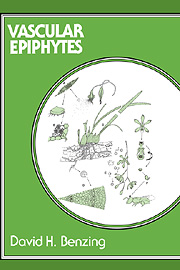1 - Epiphytism: a preliminary overview
Published online by Cambridge University Press: 29 October 2009
Summary
Historical notes
Columbus is credited with the first recorded comment on canopy-adapted vegetation; he wrote that tropical trees “have a great variety of branches and leaves, all of them growing from a single root” (Gessner 1956). The earliest known picture of an epiphyte – or, for that matter, reference to American botany – appears in The Badianus Manuscript, a Mexican herbal of 1552, written and probably illustrated by the Aztec Indian physician Martinus de la Cruz and translated into Latin by his Indian colleague Juannes Badianus at the College of Santa Cruz (Emmart 1940). The subject was Vanilla fragrans, a vining hemiepiphytic orchid. The fruit of this species (tlilxochitl in Aztec, meaning “black flower”) was an ingredient in the doctor's prescription for “The Traveler's Safeguard,” a mixture of pulverized herbs wrapped in a magnolia leaf and hung around the neck so that the voyager could “catch and inhale the very redolent odor …”
By the eighteenth century, ships' captains and explorers the world over were carrying ornamental plants, epiphytes included, back to Europe. Within decades, a brisk trade had developed; many additional aroids, bromeliads, cacti, orchids, and ferns were imported. Showiness, small size, and easy culture encouraged fads that drove prices to exorbitant levels and prompted more than one collector to lie about where he found his specimens. But scientific interest in these plants did not keep pace; other groups such as carnivores, halophytes, ruderals, and succulents are far better known today.
- Type
- Chapter
- Information
- Vascular EpiphytesGeneral Biology and Related Biota, pp. 1 - 43Publisher: Cambridge University PressPrint publication year: 1990
- 2
- Cited by



